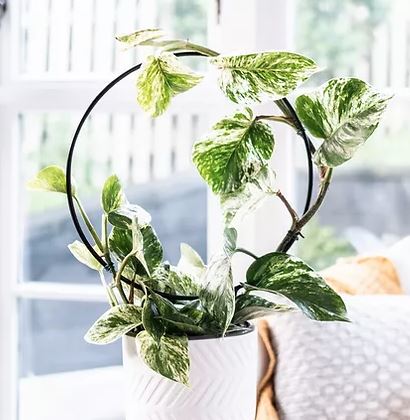Trellis for Potted Plants:
If you're an avid gardener, you know how important it is to provide support for your plants. One way to do that is by adding a trellis to your potted plants. Trellises are structures made of wood or metal that allow plants to grow vertically, helping them to stay healthy and strong. In this article, we'll discuss the benefits of using trellises for potted plants, the different types of trellises available, and how to choose the right one for your greenery.
Benefits of Using Trellises for Potted Plants
Trellises offer many benefits to potted plants, including:
1. Improved Air Circulation
Plants that are allowed to grow vertically have better air circulation around their foliage, which reduces the risk of diseases caused by stagnant air.
2. Increased Sunlight Exposure
Trellises help to raise plants off the ground, which means they get more exposure to sunlight. This is especially helpful for plants that require full sun to thrive.
3. Better Use of Space
Using a trellis allows you to make better use of your gardening space. Instead of having sprawling plants taking up valuable real estate on the ground, you can grow them vertically, freeing up room for other plants or garden features.
Types of Trellises for Potted Plants
There are several types of trellises available for potted plants. Some of the most common include:
1. Obelisk Trellises
Obelisk trellises are tall, pyramid-shaped structures that provide a lot of support for climbing plants. They're great for small potted plants or plants that need a lot of support.
2. Ladder Trellises
Ladder trellises are long, narrow structures that can be leaned against a wall or placed inside a pot. They're great for training vines and other climbing plants to grow upwards.
3. Fan Trellises
Fan trellises are shaped like a fan and are perfect for smaller potted plants. They provide enough support for plants to climb while still allowing plenty of room for air circulation.
Choosing the Right Trellis for Your Potted Plants
When choosing a trellis for your potted plants, there are several factors to consider:
1. Size
Make sure you choose a trellis that's the right size for your plant. If it's too small, it won't provide enough support, and if it's too big, it will overwhelm the plant.
2. Material
Trellises can be made of wood, metal, or plastic. Choose a material that's sturdy and will hold up to the weight of your plant.
3. Style
Choose a style of trellis that complements your garden's overall aesthetic. You want it to look good as well as provide support for your plants.
How to Add a Trellis to Your Potted Plants
Adding a trellis to your potted plants is simple. Follow these steps:
1. Choose the Right Location
Make sure you choose a location that gets plenty of sunlight and has enough room for the trellis.
2. Position the Trellis
Place the trellis in the pot, making sure it's positioned securely.
3. Train Your Plants to Climb
Gently guide your plants up the trellis, tying them in place with garden twine if necessary.
4. Provide Regular Maintenance
Make sure you provide regular maintenance for your trellised plants, including watering, fertilizing, and pruning.
Tips for Using Trellises for Potted Plants
Here are a few tips to help you get the most out of your trellises:
1. Choose the Right Plants
Not all plants are meant to be trained to climb a trellis. Make sure you choose plants that are naturally inclined to grow vertically, like tomatoes, cucumbers, and beans.
2. Use Garden Twine
Some plants may need a little extra help getting ed climbing the trellis. Use garden twine to tie the plant to the trellis until it becomes established.
3. Prune Regularly
Prune your trellised plants regularly to keep them from becoming too heavy for the trellis to support.
FAQs
1. Can I use a trellis for any type of potted plant?
No, not all plants are suitable for trellising. Only choose plants that are naturally inclined to grow vertically.
2. How do I know what size trellis to choose?
Choose a trellis that's the right size for your plant. If it's too small, it won't provide enough support, and if it's too big, it will overwhelm the plant.
3. What materials are trellises made of?
Trellises can be made of wood, metal, or plastic. Choose a material that's sturdy and will hold up to the weight of your plant.
4. How do I secure the trellis in the pot?
Make sure the trellis is positioned securely in the pot. You may need to add support stakes or use garden twine to keep it upright.
5. How often should I prune my trellised plants?
Prune your trellised plants regularly to keep them from becoming too heavy for the trellis to support. The frequency will depend on the type of plant and its growth rate.










Comments
Post a Comment